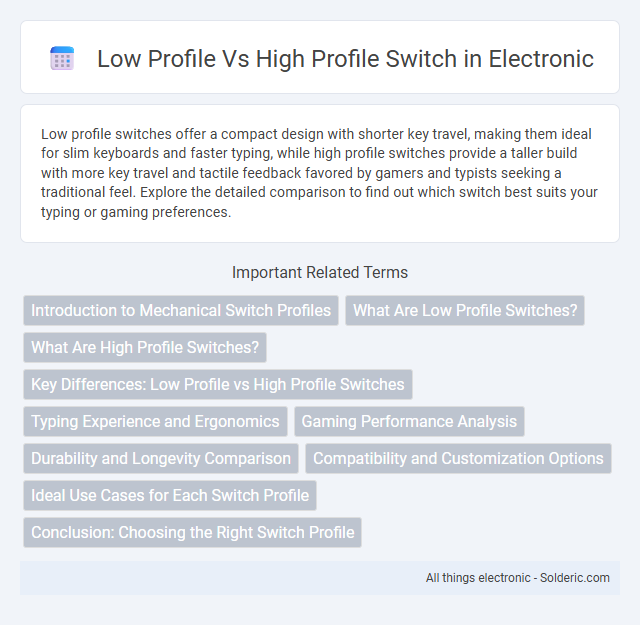Low profile switches offer a compact design with shorter key travel, making them ideal for slim keyboards and faster typing, while high profile switches provide a taller build with more key travel and tactile feedback favored by gamers and typists seeking a traditional feel. Explore the detailed comparison to find out which switch best suits your typing or gaming preferences.
Comparison Table
| Feature | Low Profile Switch | High Profile Switch |
|---|---|---|
| Height | ~3-4 mm | ~4-5 mm or more |
| Travel Distance | Shorter (2-3 mm) | Longer (4 mm or more) |
| Actuation Force | Generally lighter (30-50g) | Varies widely (45-60g+) |
| Tactile Feedback | Less pronounced | More tactile/haptic feedback |
| Use Case | Slim keyboards, laptops, portable devices | Mechanical keyboards, gaming, typing intensive tasks |
| Durability | Comparable, but fewer options | Typically higher durability options |
| Noise Level | Quieter | Louder (varies by switch type) |
| Customization | Limited options | Wide range of switch types and modding |
Introduction to Mechanical Switch Profiles
Mechanical switch profiles vary primarily between low profile and high profile designs, impacting keyboard height and key travel distance. Low profile switches offer a shorter key travel and reduced actuation force, enhancing typing speed and comfort, ideal for compact setups and portable keyboards. Your choice depends on preferred typing experience, with high profile switches providing a more tactile and traditional feel, while low profile switches deliver a faster, more responsive keystroke.
What Are Low Profile Switches?
Low profile switches are mechanical keyboard switches designed with shorter travel distances and reduced overall height for a slimmer keyboard profile. These switches offer faster actuation and a more comfortable typing experience, making them ideal for users seeking portability and ergonomic efficiency. Understanding your preference for key travel and tactile feedback will help determine if low profile switches suit your typing needs.
What Are High Profile Switches?
High profile switches are mechanical keyboard switches characterized by taller keycaps and a longer travel distance, typically around 4mm compared to low profile switches' 3mm. These switches offer a more tactile and audible typing experience favored by gamers and typists seeking precise feedback. High profile switches are compatible with standard keycaps and often used in full-sized and tenkeyless keyboards for enhanced durability and performance.
Key Differences: Low Profile vs High Profile Switches
Low profile switches feature a shorter travel distance and reduced height, making them ideal for slim keyboards and improving typing speed with less finger fatigue. High profile switches have longer travel, providing more tactile feedback and a traditional mechanical keyboard feel preferred by gamers and typists seeking precise actuation. Choosing between these switch types depends on your preference for keyboard ergonomics and typing experience.
Typing Experience and Ergonomics
Low profile switches offer a shorter travel distance and reduced actuation force, which results in faster keystrokes and less finger fatigue, enhancing typing speed and comfort for prolonged use. High profile switches provide a more pronounced tactile feedback and longer key travel, promoting precise keypresses that some typists find more satisfying and ergonomic for accuracy. Ergonomically, low profile switches reduce wrist strain due to their slim design and lower keyboard height, whereas high profile switches may require a steeper wrist angle, potentially causing discomfort during extended typing sessions.
Gaming Performance Analysis
Low profile switches offer faster actuation and shorter travel distances, enhancing your response time in fast-paced games, while high profile switches provide a more tactile and satisfying feedback that benefits precision and key stability during extended gameplay sessions. Gaming performance analysis reveals that low profile switches reduce fatigue and improve reaction speed, ideal for competitive gaming styles requiring rapid key presses. High profile switches excel in providing consistent actuation force, making them suitable for games demanding accuracy and deliberate keystrokes.
Durability and Longevity Comparison
Low profile switches typically offer less travel distance but are designed with durable materials that ensure long-lasting performance for compact keyboards. High profile switches feature more robust construction and greater actuation force, often resulting in enhanced durability and a longer lifespan under heavy typing or gaming conditions. Choosing between the two depends on Your preference for keyboard feel and how intensely You use Your device over time.
Compatibility and Customization Options
Low profile switches offer greater compatibility with slim keyboards and laptops, making them ideal for portable and space-saving setups. High profile switches provide extensive customization options, including varied spring weights and stem designs, catering to enthusiasts who prioritize tactile feedback and sound modulation. Choosing between them depends on the user's need for device compatibility versus personalized typing experience.
Ideal Use Cases for Each Switch Profile
Low profile switches are ideal for slim keyboards used in portable laptops or compact desktop setups where space-saving and typing speed are prioritized. High profile switches suit mechanical keyboards designed for gamers or typists seeking enhanced tactile feedback and longer key travel for comfort during extended use. Choosing the right switch profile depends on your ergonomic needs and the specific applications requiring either rapid key presses or more pronounced tactile response.
Conclusion: Choosing the Right Switch Profile
Selecting the right switch profile depends on your typing preferences and ergonomic needs. Low profile switches provide faster key travel and a sleek design, ideal for users seeking a compact keyboard experience. High profile switches offer more tactile feedback and durability, suitable for heavy typists who prioritize comfort and precision during prolonged use.
low profile vs high profile switch Infographic

 solderic.com
solderic.com